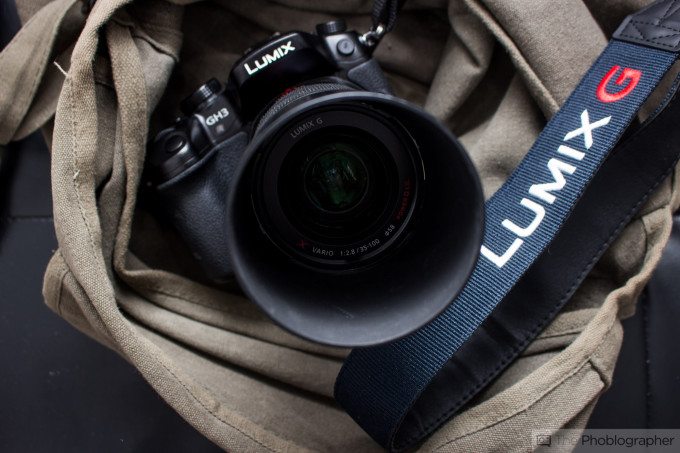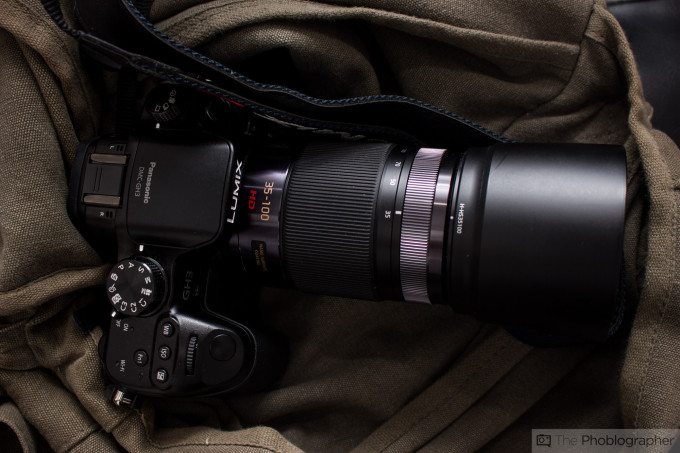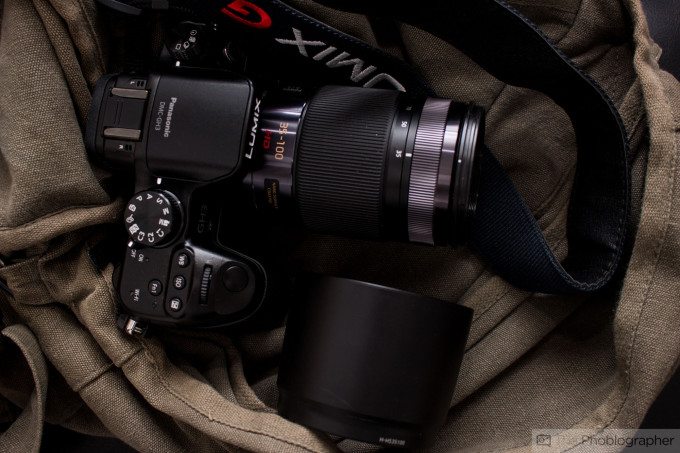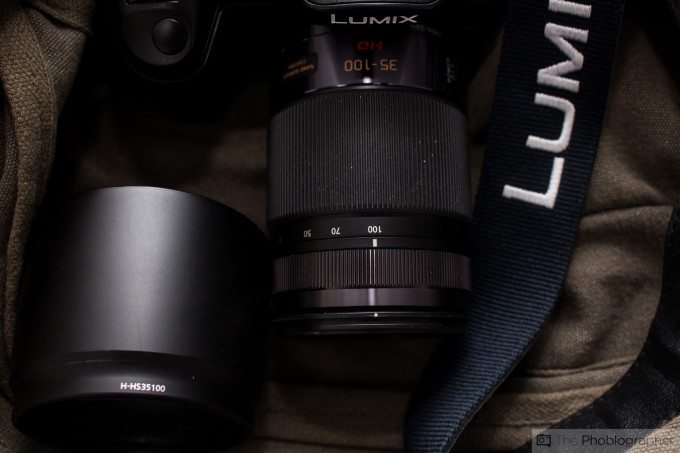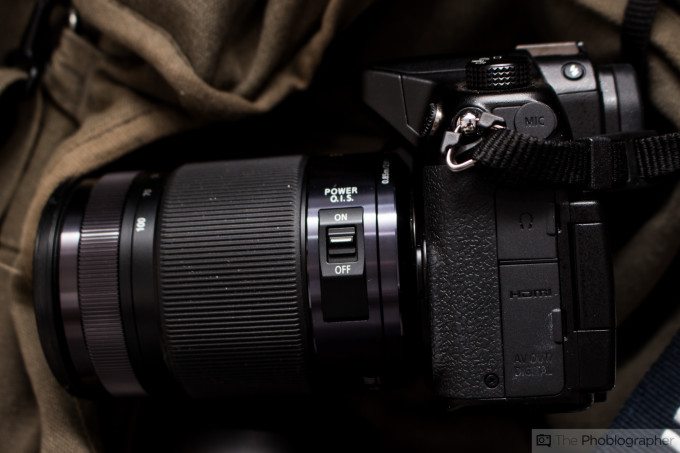If you’re looking for an excellent telephoto zoom lens for Micro Four Thirds, Panasonic has created the 35-100mm f2.8 to cover you–giving you the equivalent of a 70-200mm field of view. The lens boasts a plastic exterior with weather sealing gaskets all over. It features internal zooming to keep the package down to a minimum size. The 35-100mm f2.8 focuses extremely quick and also offers great image quality.
The lens is characterized not only by weather sealing and a constant aperture through the zoom range, but seven aperture blades, 18 elements in 13 groups, image stabilization, and when you put that all together you get one heck of a kick ass portrait lens for the Micro Four Thirds system.
Pros and Cons
Pros
– Some of the best image quality that we’ve seen from a Micro Four Thirds zoom lens
– Built in stabilization
– Low distortion
– Already very sharp but when you add a strobe to give specular highlights you’ll see your image sparkle
– Weather sealing
– Beautiful colors
Cons
– Expensive
– The lens hood is basically the size of the lens body
– Plastic exterior
Gear Used
We tested the Panasonic 35-100mm f2.8 lens with the Panasonic GH3, Westcott Rapid Box Mini Octa, Yongnuo 560 III, and the Olympus OMD EM5.
Tech Specs
Specs taken from the B&H Photo Video listing
| Features | |
|---|---|
| Image Stabilization | Yes 1 |
| Autofocus | Yes |
| Physical | |
|---|---|
| Filter Thread | 58 mm |
| Dimensions (DxL) | Approx. 2.7 x 3.9″ (6.86 x 9.91 cm) |
| Weight | 12.7 oz (360 g) |
Ergonomics
Panasonic’s 35-100mm f2.8 has quite the look to it. Since it is a telephoto lens, the body is naturally longer–though the lens hood takes up quite a lot of the overall package.
This lens is characterized by two major rings: a zoom ring and a focusing ring. Panasonic decided to make the zoom ring big and beefy and put it towards the back. On the other hand, the focusing ring is thin and towards the front.
Throughout the zoom range, Panasonic has put markers designating what focal length you are currently using. Unfortunately, they neglected to put a distance scale on this lens, so you never really know how far out you’re focusing unless you look at the screen.
On the side of this lens is the one and only control: OIS. The enables or disables the function. Want to manually focus? You’ll need to enter the camera’s menu system and set it from there.
Build Quality
The exterior is made of plastic with some metal elements. The smooth, glossy plastic areas feel a bit tacky, but this feeling is overall negated by the way that the big zoom ring feels. Indeed, this is how zoom rings should be designed: big, beefy, and full.
With all of this said, this lens is weather sealed and we took it out during a shower in Williamsburg. It stood up to the rain without any harm.
Autofocusing
This lens focuses very quickly on the Panasonic GH3 and a tad slower on the Olympus OMD EM5. Since this lens is targeted at the professional photographer, you’ll be happy to know that it can focus quickly on both moving subjects and stagnant subjects. But for the best and fastest results, we recommend choosing a focusing point vs having the camera decide for you.
Of all the lenses that we tested on the Panasonic GH3, this was perhaps the fastest to focus.
Ease of Use
Point, shoot, adore–it’s the same song that we play with every other Panasonic lens for Micro Four Thirds. If you’re switching to tripod usage vs handheld, we recommend that you remember to turn off the OIS feature.
Image Quality
Kitty! Oh man! Cute kitty!
Sorry.
Back to being serious: the image quality from the Panasonic 35-100mm f2.8 is nothing short of jaw dropping. Though f2.8 is too slow for Micro Four Thirds in general because of the 2x crop factor making it an equivalent f5.6 in 35mm full frame, this lens still can give you some awesome bokeh. But great image quality isn’t only about bokeh–it is also about sharpness, top notch colors, and keeping the distortion down. And then there is what you’re exactly doing with the lens.
Color Rendition
When I shot the above photo and chimped the LCD screen of the GH3, I literally uttered, “Jesus Christ, this is awesome.” And it really is. Panasonic’s color rendering on the GH3 is different from the OMD EM5’s despite reports saying that it is the same sensor. We were incredibly dumbfounded with the way that it renders reds, blues, and greens.
Color Fringing
In our tests with both flashes and natural lighting, we didn’t find very much color fringing at all. Any that we found was created by us bumping up the contrast in Lightroom. And even if you can find some, it really isn’t a big thing to worry about vs the overall quality of the picture.
Sharpness

And here is where this lens basically destroys nearly everything else on the market for Micro Four Thirds. The sharpness of this lens wide open is uncanny. Again, we really recommend using it with a diffused flash or lighting the way that we did with the photo on the left. It was set up by using a Westcott Rapid Box Mini Octa and the Yongnuo 560 III being diffused through it.
Adding to the sharpness is the built in Optical Image Stabilzation–which helps to keep your images sharp and blur free from camera shake. The photo was taken with the modifier held in one hand while the camera was in the other.
Sure, her glasses are sharp but who cares when it is this sharp wide open.
Portrait photographers looking to get into the Micro Four Thirds game have a viable option besides Olympus’s 45mm f1.8 and 75mm f1.8. Both of those are stellar prime lenses and excellent for portrait taking. To boot, they also have a tad more than an extra stop of light soaking abilities due to the faster apertures. And even then, we wouldn’t really stop them down unless we needed to.
In the recent years, we have also seen wedding photographers and fashion photographers start taking up the Micro Four Thirds banner as well. Once again, if you miss your old 70-200mm f2.8 from your DSLR, this lens is your answer.
Photojournalists looking for a compact zoom lens may also want to spring for this and the 12-35mm f2.8 together if they want to cover a whole focal length range. Otherwise, a couple of small primes still help to keep the camera body small–and that is what Micro Four Thirds was designed to do in the first place.
To sum up, if you’re looking for a super sharp and very compact telephoto zoom lens for the system, this is the one that belongs in your camera bag.
Distortion
At 35mm, we saw a little bit of distortion–but not so much that we would sit in a corner, cry to ourselves, and rock back and forth muttering that it’ll all go away with Lightroom. It’s surely bearable. At the longer end of the lens, there is no visible distortion–which only makes sense.
In practice, that means that you’ll need to shoot your portraits at a 200mm focal length if you want to do a proper headshot.
Extra Image Samples
Conclusions
Of any of the lenses that I used with the Panasonic GH3, this one is perhaps my favorite and the only one that I would actually purchase. I often don’t shoot with long focal lengths unless I need to–and it would be nice to have a variety of them to keep the lens bag not too heavy. This lens exhibits mesmerizing sharpness, wonderful bokeh, excellent colors, great stabilization, and a build quality that will be able to keep up with your rough and tumble life despite the plastic exterior.
It’s totally worth it for anyone that needs to shoot long. If you’re a sports photographer though, you’ll surely need something longer. A lens like this won’t cut it.
Either way, this lens gets our highest recommendations but we really wish that the exterior were made in metal except for plastic for personal aesthetics.
You can snag your very own lens from B&H Photo.
Recommended Cameras and Accessories
– Panasonic GH3: With the GH3, this lens will have the fastest focusing. The GH3 is also weather sealed–which is another plus when using a weather sealed lens like this. See our review here.
– Olympus OMD EM5: The OMD is also weather sealed, but you’ll suffer from a slower focusing algorithm when using this lens on an Olympus body.
– Yongnuo 560 III: If you’re a Micro Four Thirds user looking to get into the pro game arena, then this flash might be your best bet. It has radio transmission built in and the specular highlights it gives off will compliment this lens’s sharpness very well. You won’t be dissatisfied. See our review here.
Please Support The Phoblographer
We love to bring you guys the latest and greatest news and gear related stuff. However, we can’t keep doing that unless we have your continued support. If you would like to purchase any of the items mentioned, please do so by clicking our links first and then purchasing the items as we then get a small portion of the sale to help run the website.


